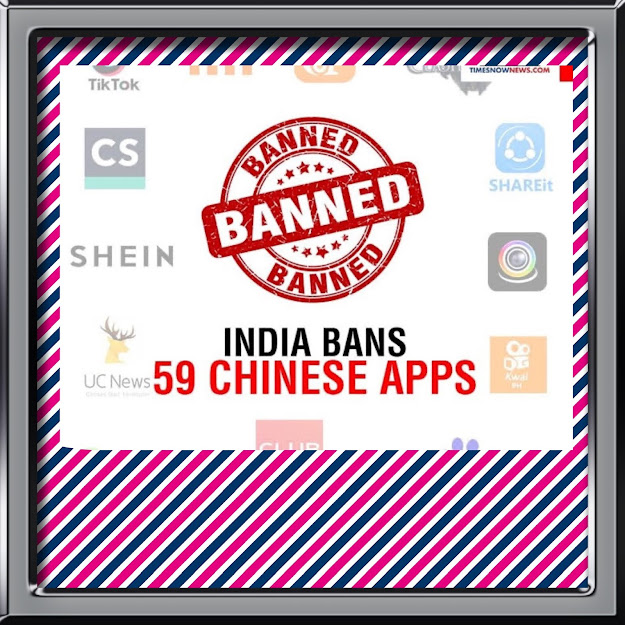BANNING OF CHINESE APPS IN INDIA- (Blog)
Where
the whole world is fighting against the deadly coronavirus, India is also
fighting a battle with its neighbouring country China. Where there is high
tension on the indo-china border and the dispute regarding the stretch of land
along the Sino-India border continues, the digital connections with China are
now being withdrawn by India.
On 29th
June, 2020, India banned 59 Chinese apps including social media platforms such
as tik-tok, helo, WeChat and other apps as well such as UC browser, shareit,
shein, etc. According to the Indian government such measures has been taken to
protect the interest of the nation and for its security. The government through
its press release by the ministry of electronics and information technology
stated that’s these apps were a threat to the sovereignty and integrity of the
nation and these apps were being used by the neighbouring country to transfer
the data from the Indian users to other countries unauthorizedly. Even after
banning of these 49 apps, 47 more apps were operating as colons of the
previously banned apps. A list of 275 apps has been prepared lately by the
government. The government will conduct scrutiny of these applications to
ensure that they are not in violation of the security and integrity of the
country. The list includes popular gaming app PUBG, economic giant ALIBABA,
XIAOMI, and other Chinese apps.
LAW
APPLICABLE
The
Indian government’s decision of banning these Chinese apps has been exercised
under section 69A of the information technology act, 2000 that reads with
certain provisions of Information Technology (Procedure and Safeguards for
Blocking of Access of Information by the citizens) Rules, 2009. The sections
give power to the government to ban any website or application that imposes
some kind of threat to the countries defence, sovereignty, integrity, or law
and order of the country. This section can also be used in case of an
“emergency” where an interim measure issuing the ban of the website can be
directed.
Since
the information on the banning of 59 Chinese app was disclosed by the
government through a press release and no detailed information was given for
the same so the act of banning these apps is void ab- intio, as it does not,
fulfill the requirement of section 69A of IT act.
In Shreya
Singhal v/s Union of India [1], the Supreme Court held that section
69A was constitutional and a ban on applications can be imposed through a
detailed and reasoned order. The court also said that the ban can be issued
only on the committee’s approval and after the hearing of the aggrieved party
and the reason for such blocking has to be clearly stated in writing even in
case of emergency.
There
are certain rules that have been led down in Information Technology (Procedure
and Safeguards for Blocking of Access of Information by the citizens) Rules,
2009 also known as the blocking rules that are to be followed by the government
before passing the blocking orders. However, these sets of rules were not
completed by the government while banning 59 Chinese apps in India and the
action of the government was not in conformity with the rule of law.
CONCLUSION
Though
the actions of the government aimed at protecting the security of the nation
but these actions did not satisfy the legal provisions of section 64A of IT
act. Proper blocking procedure was not followed by the government. The
government is bound to provide proper reasoning of its orders to block such
applications to protect the right to information of the citizens. If the
government takes such actions in the future then it must ensure that a proper
procedure is followed while doing so that its decisions can sustain all legal
challenges imposed on it.
[1] Singhal v. Union
of India, (2013) 12 S.C.C. 73




Comments
Post a Comment